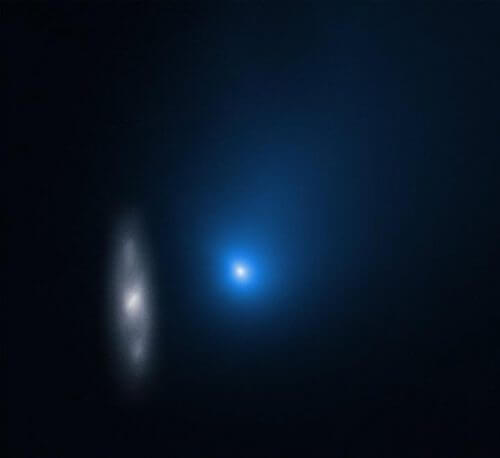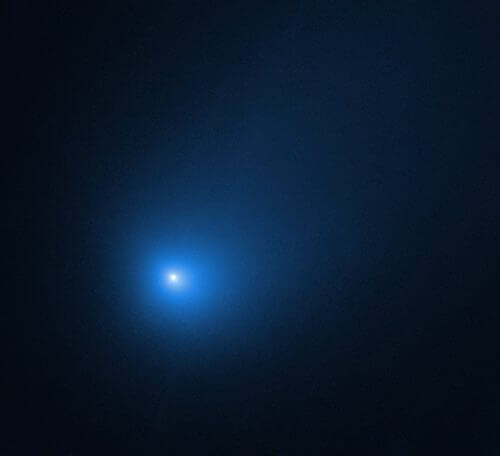
The Hubble Space Telescope has again photographed Comet 2I / Borisov passing through our solar system on its way back to interstellar space. At a breathtaking speed of over 175 km/h, Borisov is one of the fastest comets ever observed. It is only the second interstellar object that has been shown to have passed through the solar system.
In October 2019, the Hubble Space Telescope observed a comet approximately 420 million km from Earth. These new observations that took place in November and December 2019 when the comet was at a closer distance provide clearer insights into the details and dimensions of the interstellar visitor [1].
The first image shows the comet in front of a distant spiral galaxy (2MASX J10500165-0152029). The bright central nucleus of the galaxy is smeared in the image because Hubble follows the comet. Borisov was 326 million km from Earth at this exposure. The tail of dust ejected from it faces the upper right edge.
The second image is Hubble's renewed observation of the comet near its closest point to the Sun. There he was subjected to extreme temperatures, especially after spending most of his life in the extreme cold of interstellar space. The comet is in this image at a distance of 298 million km from Earth, near the inner edge of the asteroid belt. The nucleus, a loose mass of ice and dust, is still too small to be observed individually. The bright central part is a cloud composed of dust ejected from the surface of the comet. The comet will reach its closest point to Earth at the end of December, when it will be 290 million km away.

"Hubble gives us the best measurement of the size of Comet Borisov's nucleus, which is the really important part of the comet," said David Jewitt, a professor of planetary sciences at UCLA whose team took the best and sharpest images of Borisov. "Surprisingly, our Hubble images show that its core is 15 times smaller than previous studies estimated it might be. The nuclear radius is less than half a kilometer. This is an important figure because knowing the size helps us determine the mass of such objects in the solar system and the Milky Way. Borisov is the first known interstellar comet, and we want to know how many others there are. "
Gennady Borisov, an amateur astronomer from Crimea discovered the comet on August 30, 2019. After a week of observations by amateur and professional astronomers all over the world, the International Astronomical Union's Medium Star Center calculated the comet's trajectory which showed it came from interstellar space. So far all cataloged comets have come from a ring of frozen debris at the edge of our solar system, known as the Kuiper Belt, or from the Oort Cloud, a shell of icy objects considered the outermost regions of the Solar System, whose innermost edge is 2000 times the distance from Earth to the Sun.
Borisov may represent just the beginning of a series of discoveries of interstellar objects making a brief visit to our solar system. Our solar system would be thought to be filled with thousands of such interstellar objects at any given time; However, most of them are too faint to detect with today's telescopes.
The observations by Hubble and other telescopes have shown that rings and clouds of icy debris surround young stars. Gravitational interaction between the comet-like objects and other massive bodies could cause them to be thrown deep into space and fly among the stars.

18 תגובות
In my opinion the universe behaves in the visible region but we see it and in another place it is possible that it behaves completely differently, therefore all theories are good for the limited region of the observable region and much in front of it as long as we have not physically reached the really distant places
In my opinion the universe behaves in the visible region but we see it and in another place it is possible that it behaves completely differently, therefore all theories are good for the limited region of the observable region and much in front of it as long as we have not physically reached the really distant places
Hi Judah,
I see that you have written a quote on your blog almost one for one of the hypothesis I have made here.
I would appreciate it if you could indicate that this hypothesis came from me.
Thanks,
Eli Isaac
https://eisaak123.wixsite.com/privatelessons
Hi Judah,
I see that you have written a quote on your blog almost one for one of the hypothesis I have made here.
I would appreciate it if you could state in your blog that this hypothesis came from me and maybe even refer to my link below.
Here are links to my comment and your blog article:
My response with my hypothesis above: December 16, 2019 at 14:57 pm
This is your blog article where you quote my response here:
http://yekumpashut.freevar.com/?page_id=272
Thanks,
Eli Isaac
https://eisaak123.wixsite.com/privatelessons
Thank you Yehuda and Ariel for your answers to my response (it seems to me that you gave conflicting answers).
Another question of mine on the subject, if we assume that there is no dark energy then basically it means that the void of the universe is attractive
the material to it without using energy.
How can there be movement without energy?
If it is done with energy, then what is its source?
Maybe the void was also created by an initial explosion?
By the way, more questions that interest me:
1) It is said that the earth is used as grounding. Indeed, the lightnings find their way to the ground.
So why when I connect the plus of the battery through a small lamp to ground then the lamp does not
Did you light up?
2) It is said that the connection between electricity and electromagnetism was found by a scientist who saw that the compass needle moved near
power line
Why when I bring a compass close to an electric wire with a strong current passing through it, I don't see a movement of the compass?
Why when I wind the power cord (220v with a current of about 2A) there is still no magnetic attraction?
3) Why sometimes I see planes drawing lines in the sky but these lines don't disappear but turn around
over time to form long clouds (not ordinary sheep clouds). It has to do with a so-called contact theory
Chemotrail (search on Google).
Eli Isaac
Lali Isaac
Your approach is correct there is no need for dark energy to justify the accelerated expansion of the universe. A galaxy located inside the universe, which actually behaves as a gaseous space, has a greater pressure acting on it from the inside out than from the outside in, hence the outward acceleration
Sabdarmish Yehuda
It is still much hotter than interstellar space
What extreme heat? It passes at the distance of Mars from the Sun. Comets are an electrical phenomenon. Not ice, just a rock with a different charge that reacts to the electric current called the solar wind.
Hey Eli,
An interesting idea, but it is problematic because you still do not explain the acceleration of the galaxies. An ideal gas spreads in a vacuum at a constant speed, there is no interaction between particles, hence its name - ideal gas. What you describe was the prevailing approach among cosmologists until 1990 who thought it was a primordial 'explosion' and expected to see a slowing of the expansion. After the results that showed that the expansion of the universe is accelerating and the dark energy model came to explain this acceleration.
This is how the human brain is occupied and the earth is robbed. A gross lie. No human has ever set foot on the soil of the moon
My idea regarding the acceleration of galaxies:
I recently learned that since the big bang (if there was one) the galaxies have been moving away from each other not at a constant or decelerating speed (as a result of the decay of the energy of the explosion) but at an increasing speed (acceleration).
I learned that the scientists hypothesize that it is dark energy that causes this acceleration (that is, energy that we do not know how to locate).
I suggest another idea, I wonder if it's a good idea:
If a gas is released into an area that has a void (vacuum), then the gas quickly diffuses in that area and fills the void.
This is probably done without an investment of energy.
It seems to me that the infinite universe is an area of emptiness and the galaxies (created from the big bang) are simply scattered in the area
The void is like the molecules of the gas.
Basically, it is nature's behavior to strive for balance.
Even water, for example in reverse osmosis, flows from a low salt concentration to a high salt concentration.
Or for example hot water that mixes quickly with cold water.
Anonymous is right,
for example:
"And the Milky Way"
"objects"
The translation and/or the Hebrew syntax
Not good, it's Hebrew from English
Borisov passed through the solar system
and brought Boris Johnson the victory
Yehuda
Planetary gravity is used to accelerate spacecraft. The idea is that the spacecraft "steals" kinetic energy from the planet. In other words, part of the planet's orbital speed is transferred to the spacecraft.
For example Voyager I used Jupiter and Saturn to get out of the solar system.
So - perhaps the meaning here is that the comet gained speed, from the peripheral speed of the sun (after all, the comet came from outside the solar system - and the sun circles the Milky Way).
This is just a hypothesis - and logic tells me that you are right...
I think it is not a comet but a disguised spaceship like the Omamoha object that passed in an orbit that appears to be a completely artificial orbit
The title of the article is problematic. A body cannot pass the sun and accelerate. As long as the body approaches the sun it accelerates but when it passes it and moves away then it must slow down.
Perhaps the above-mentioned goch is currently only approaching the sun and is therefore currently accelerating. Plus defining the Kuiper belt as debris is a bit jarring.
That's my opinion.
Please respond gently. Thanks.
Yehuda
http://yekumpashut.freevar.com/